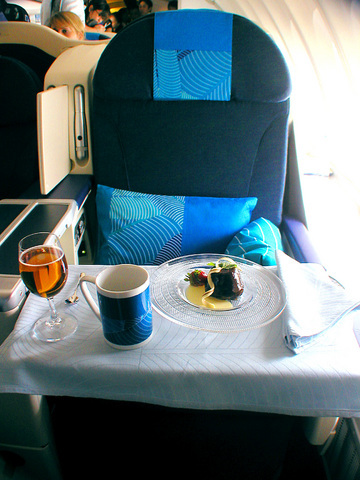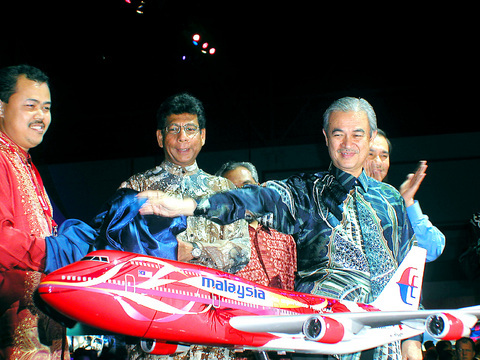On March 24 in Kuala Lumpur, Malaysian Prime Minister Datuk Seri Abdullah Ahmad Badawi officially launched Malaysia Airlines' new customer service program titled "An Experience Redefined," which includes a comprehensive aircraft cabin upgrade aimed at securing a greater segment of the premium travel market.
As part of the FM700 million (US$180 million) upgrade program, the cabins in 17 Boeing 777-200s and 17 Boeing 747-400s are to be progressively refurbished with the latest technologies, styles and innovative designs and brought into service over the coming year and a half.
The upgrading of aircraft at Malaysia Airlines, the country's national carrier, is in line with the prime minister's call issued last week to elevate the production value of Malaysian products. The prime minister said Malaysia should "promote itself as a global brand with a corporate image," highlighting the need to improve the standard of the service sector to gain new markets for its value-added products.

Malaysia Airlines, the prime minister said, sets the standard for high-quality Malaysian products, having consistently earned awards in numerous categories, notably earning the best cabin staff distinction for several years running.
At the unveiling of the new cabins, Managing Director of Malaysia Airlines Dato' Ahmad Fuaad Dahlan said: "It is all about creating an entirely new experience for our premium passengers, from seat luxury and comfort, to high-end inflight entertainment and fine dining. All these within a cabin ambience created to appeal to the senses, and delivered by cabin crew who have done us proud by being rated the world's best, year on year."
During the course of the cabin and service upgrade program, more than 3,000 crew members will be trained to provide increased interaction with passengers.

As the main feature of the cabin upgrade, front-end passengers will be able to take advantage of improved seat comfort with an 203cm seat pitch and flat bed facility in the first class of the B747-400 aircraft, and a 147cm seat pitch with angled flat beds in the business class of both the B747 and B777 aircraft. The Kuala Lumpur to Taipei route will be served initially by B777 aircraft with the possibility next year of the Kuala Lumpur to Los Angeles route flying via Taipei with a refurbished B747.
The new first-class cabin on the B747-400 aircraft will provide a completely new interior, the centerpiece of which is the new privacy shell with an electrically operated seat that reclines into a full-sized flat bed or in its upright position allows space for a large dining table with an extra seat that permits dining for two.
The business-class seats in both aircraft types will also be fully reconfigured. The seat can recline to an angle of 8? made possible by additional legroom that has been built into the design. In addition, a sliding divider between seats will provide a higher level of privacy than in previous configurations.
The upgrade program is also extended to inflight entertainment. The new entertainment system will be provided throughout all aircraft, meaning that all passengers, regardless of class, will be able to watch up to 40 movies, 60 short features and listen to a library of 200 CD titles selected on new touch-screen monitors. The new system also includes functions for all passengers to send and receive text messages and e-mails from their seats.
With regard to the new inflight entertainment features and their inclusion in the economy class cabins, Dato' Ahmad Fuaad said: "We value this class of passengers too -- increasingly younger, more IT savvy, and who are our potential premium passengers."
The B777-200 aircraft design will convert the three classes into a two-class configuration: business and economy. There will be 42 business-class seats and 247 economy-class seats. The B747-400 will still have all three classes but fewer seats overall, with 12 in first class, 41 in business class and 306 economy class seats.
The final feature of the upgrade will be newly designed exteriors for the planes, which will employ unique hibiscus, heliconia and ribbon motifs, which will mirror the red and blue tones of the refurbished cabins. The hibiscus is Malaysia's national flower.

“Why does Taiwan identity decline?”a group of researchers lead by University of Nevada political scientist Austin Wang (王宏恩) asked in a recent paper. After all, it is not difficult to explain the rise in Taiwanese identity after the early 1990s. But no model predicted its decline during the 2016-2018 period, they say. After testing various alternative explanations, Wang et al argue that the fall-off in Taiwanese identity during that period is related to voter hedging based on the performance of the Democratic Progressive Party (DPP). Since the DPP is perceived as the guardian of Taiwan identity, when it performs well,

The Taiwan People’s Party (TPP) on May 18 held a rally in Taichung to mark the anniversary of President William Lai’s (賴清德) inauguration on May 20. The title of the rally could be loosely translated to “May 18 recall fraudulent goods” (518退貨ㄌㄨㄚˋ!). Unlike in English, where the terms are the same, “recall” (退貨) in this context refers to product recalls due to damaged, defective or fraudulent merchandise, not the political recalls (罷免) currently dominating the headlines. I attended the rally to determine if the impression was correct that the TPP under party Chairman Huang Kuo-Chang (黃國昌) had little of a

At Computex 2025, Nvidia CEO Jensen Huang (黃仁勳) urged the government to subsidize AI. “All schools in Taiwan must integrate AI into their curricula,” he declared. A few months earlier, he said, “If I were a student today, I’d immediately start using tools like ChatGPT, Gemini Pro and Grok to learn, write and accelerate my thinking.” Huang sees the AI-bullet train leaving the station. And as one of its drivers, he’s worried about youth not getting on board — bad for their careers, and bad for his workforce. As a semiconductor supply-chain powerhouse and AI hub wannabe, Taiwan is seeing

Jade Mountain (玉山) — Taiwan’s highest peak — is the ultimate goal for those attempting a through-hike of the Mountains to Sea National Greenway (山海圳國家綠道), and that’s precisely where we’re headed in this final installment of a quartet of articles covering the Greenway. Picking up the trail at the Tsou tribal villages of Dabang and Tefuye, it’s worth stocking up on provisions before setting off, since — aside from the scant offerings available on the mountain’s Dongpu Lodge (東埔山莊) and Paiyun Lodge’s (排雲山莊) meal service — there’s nowhere to get food from here on out. TEFUYE HISTORIC TRAIL The journey recommences with